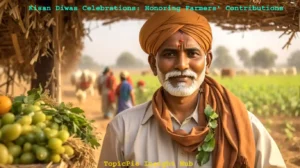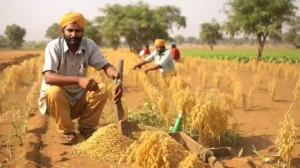Introduction:
Every December 23rd, India celebrates Kisan Diwas. It’s a day dedicated to honoring farmers’ hard work and dedication. This special occasion recognizes their contributions and emphasizes their vital role in feeding the nation.
Kisan Diwas is significant, shedding light on farmers’ challenges from seed to harvest. It’s an opportunity to understand their immense efforts in cultivating crops and sustaining the agricultural industry. Delving deeper into their lives during this day provides valuable insights.
In this blog post, we’ll delve into the history and theme of Kisan Diwas. Join us as we explore each farming stage. Embark on a captivating journey from preparing the land and sowing seeds to nurturing crops in unpredictable climatic conditions. Join us in celebrating this important day by delving into the fascinating world of agriculture!
The Significance of Kisan Diwas:
Kisan Diwas, celebrated on December 23rd annually, is a significant observance in India. It honors farmers’ contributions and hard work, recognizing Chaudhary Charan Singh, the former Prime Minister, and dedicated advocate for farmers’ rights.
This special day holds great importance as it acknowledges the invaluable role played by farmers in ensuring food security and sustenance for our nation. Farmers are the backbone of our agricultural sector, working tirelessly to cultivate crops and provide nourishment for millions of people.
Kisan Diwas serves as a platform to recognize their efforts and express gratitude towards them. It encourages society to understand and appreciate farmers’ challenges, like unpredictable weather conditions and pests. Market fluctuations and the lack of access to modern technology also pose difficulties. By highlighting these issues, Kisan Diwas aims to create awareness about the need for support systems and policies that can improve their lives.
Also Read: Vikshit Bharat Sankalp Yatra: Hamara Sankalp Viksit Bharat
Moreover, this day offers an opportunity for policymakers and government officials to collaborate. Agricultural experts, NGOs, and stakeholders discuss initiatives for empowering farmers, ensuring better resources, fair prices, and improved infrastructure.
The goal is not only to celebrate their contribution but also find ways to uplift their socio-economic status.
On Kisan Diwas, schools, colleges, government institutions, and various organizations organize events, farmers’ fairs, cultural programs, discussions on farming techniques, distribution of awards, and felicitations.
Well-known personalities from different fields often participate in these events, to show solidarity with Indian agriculture.
This helps foster connections between rural communities, the government, businesses, and urban consumers, resulting in increased understanding, support, and collaboration between all parties involved.
Overall, Kisan Diwas serves as a reminder that without farmers, the world would go hungry.
It emphasizes the significance of sustainable agriculture practices, respect for nature’s cycles and the crucial role played by those who toil in the fields. It is a day of appreciation, reflection, and action towards making the lives of farmers better.
Kisan Diwas is a vital occasion that reminds us to be grateful for the hard work and sacrifices of our farmers. It also serves as a call to action for creating a more sustainable and equitable agricultural sector in India. Let us use this day to not only celebrate but also support and uplift our farmers in every way possible.

The History of Kisan Diwas:
Kisan Diwas, also known as Farmers’ Day, is a significant observance in India that celebrates the contributions and achievements of farmers. This day holds great importance as it acknowledges the vital role that farmers play in ensuring food security for the nation.
The origins of Kisan Diwas can be traced back to 23rd December 2001 when Atal Bihari Vajpayee, the former Prime Minister of India, declared this day as National Farmer’s Day. The decision was made to commemorate the birth anniversary of Chaudhary Charan Singh, an eminent leader and farmer himself.
Chaudhary Charan Singh dedicated his life to advocating for agrarian reforms and championing the rights of farmers. He served as the country’s Prime Minister from 1979 to 1980 and played a crucial role in implementing policies that aimed at improving agricultural practices and empowering farmers.
Since then, Kisan Diwas has been celebrated annually on 23rd December with various events organized across the country. These events include rallies, seminars, exhibitions, workshops, and cultural programs that highlight the significance of agriculture in our society.
Kisan Diwas serves not only as a tribute to Chaudhary Charan Singh but also as an opportunity to raise awareness about issues faced by farmers such as low income, lack of access to modern technology and resources, inadequate infrastructure support, etc.
It is through this celebration that efforts are made not only to recognize their hard work but also promote initiatives that address these challenges and provide support systems for better livelihoods for our farming community.
The Theme of Kisan Diwas:
The theme of Kisan Diwas revolves around celebrating and acknowledging the invaluable contribution of farmers in our society. It serves as a platform to honor their hard work, dedication, and resilience in feeding the nation. This day is an opportunity for us to appreciate the blood, sweat, and tears that go into every crop harvested.
One of the main themes emphasized during Kisan Diwas is the importance of sustainable agriculture. As we face numerous environmental challenges, it becomes imperative to adopt practices that promote ecological balance and minimize harm to our planet. Farmers are encouraged to implement eco-friendly techniques such as organic farming, water conservation methods, and integrated pest management systems.
Another crucial aspect highlighted on this day is rural development. The well-being of farmers extends beyond their fields; it encompasses their overall quality of life. Kisan Diwas aims to draw attention towards providing better infrastructure in rural areas such as improved irrigation facilities, access to education and healthcare services, electrification projects, and financial support for agricultural advancements.
Furthermore, Kisan Diwas also emphasizes empowering farmers through technological advancements. With innovations like precision agriculture technologies, digital platforms for market access or weather forecasting apps can help optimize yield while reducing input costs. By embracing these tools and knowledge-sharing platforms tailored specifically for farmers’ needs can significantly enhance productivity levels.
Ultimately, the theme of Kisan Diwas promotes unity within communities by recognizing the profound impact that agriculture has on our daily lives.
The celebration serves as a reminder that supporting our farmers is not just limited to one day but should be an ongoing effort throughout the year. By acknowledging their contribution and addressing their needs, we can create a more sustainable and prosperous future for our nation.

The Journey of a Farmer: From Seed to Harvest
The journey of a farmer, from seed to harvest, is a testament to hard work, dedication, and the unpredictable nature of agriculture. It all begins with preparing the land and sowing seeds. The farmer carefully tills the soil, removing weeds and rocks that could hinder the growth of crops. With precision and care, they plant each seed in its designated spot, ensuring optimal spacing for healthy growth.
Once the seeds are planted, the farmer’s role shifts to nurturing and protecting the crops. They provide water and nutrients through irrigation systems or natural rainfall. Constant monitoring is essential to identify any signs of pests or diseases that may pose a threat to crop health. Integrated pest management techniques are employed to minimize chemical usage while maintaining crop productivity.
Dealing with climate and environmental factors is another challenge faced by farmers on their journey from seed to harvest. Unpredictable weather patterns can wreak havoc on crops – droughts can parch fields while excessive rain can lead to flooding. Farmers must adapt quickly by implementing strategies such as using drought-resistant varieties or employing proper drainage systems.
Finally comes the much-anticipated moment – harvesting! The fruits of labor are reaped when crops have reached their peak maturity. This involves careful timing as different crops have varying maturation periods; some require hand-picking while others need specialized machinery for efficient harvesting.
Post-harvest processing and storage play an important role in ensuring maximum value from harvested produce. Sorting, cleaning, packaging, transportation – these steps contribute significantly towards maintaining quality until it reaches consumer markets or storage facilities.
The journey of a farmer from seed to harvest encompasses numerous challenges along with moments filled with hope and fulfillment. Their dedication ensures we have access to fresh food on our tables every day.
Preparing the Land and Sowing Seeds
One of the crucial stages in a farmer’s journey is preparing the land and sowing seeds. This initial step sets the foundation for a successful harvest. Before sowing, farmers need to ensure that their land is properly prepared to provide an optimal growing environment for the crops.
To begin with, farmers assess the soil condition by conducting soil tests to determine its fertility levels and nutrient content. Based on these results, they may need to add fertilizers or organic manure to enrich the soil with essential nutrients.
Next, comes ploughing and tilling of the land. This process helps loosen up compacted soil, improves water drainage, and creates a favorable seedbed. Farmers use various tools such as tractors or oxen-driven ploughs depending on their resources.
Once the land is ready, it’s time for seed selection. Farmers carefully choose high-quality seeds that are suitable for their specific crop type and local climatic conditions. They consider factors like disease resistance, yield potential, maturity period, and market demand while making this decision.
Also Read: Sustainable Living: Tips for an Eco-Friendly Everyday Life
Sowing techniques also play a vital role in ensuring proper seed placement for optimal germination rates. Depending on crop type and equipment availability, farmers may opt for broadcasting (scattering seeds across fields), drilling (placing seeds at uniform depths using machinery), or transplanting (moving young plants from nurseries).
After sowing seeds accurately at recommended spacing intervals between rows and plants within rows based on crop requirements; irrigation methods come into play; providing adequate water supply during germination ensures healthy plant growth.
The process of preparing lands involves numerous tasks like evaluating soil fertility levels through testing procedures followed by necessary amendments if required; performing ploughing operations using appropriate tools; selecting quality seeds suited best according to local climate conditions; deploying accurate sowing techniques along with maintaining proper irrigation practices—all contributing towards setting strong foundations for a bountiful harvest ahead.

Nurturing and Protecting the Crops
Nurturing and protecting the crops is a crucial aspect of a farmer’s journey. Once the seeds are sown, it is essential to provide them with the care they need to thrive and grow into healthy plants. This involves regular watering, providing adequate sunlight, and ensuring proper nutrition.
Farmers often spend hours tending to their crops, monitoring their growth, and taking necessary measures to protect them from pests and diseases. They may use organic or chemical pesticides depending on their farming practices.
Weeds can also pose a threat to crops by competing for nutrients and space. Farmers employ various weed control methods such as manual weeding or using herbicides to keep weeds at bay.
In addition to these efforts, farmers must also be vigilant about weather conditions that can impact crop health. Excessive rain or drought can have adverse effects on plant growth. Therefore, farmers closely monitor weather forecasts and take appropriate actions like irrigating during dry spells or protecting plants from heavy rainfall.
Protecting crops extends beyond just physical care; it also involves safeguarding against natural calamities such as floods or storms. Farmers may invest in infrastructure like protective covers or shelters that shield the crops from extreme weather events.
By nurturing and protecting their crops diligently throughout the growing season, farmers increase the chances of obtaining a bountiful harvest while minimizing losses due to pests, diseases, or environmental factors. Their dedication ensures that consumers have access to fresh produce while contributing significantly towards food security in our nation.
Dealing with Climate and Environmental Factors
Farming is a challenging endeavor, and one of the biggest hurdles that farmers face is dealing with climate and environmental factors. Mother Nature can be both a friend and a foe to farmers, as they rely on favorable weather conditions for their crops to thrive.
One of the main climate factors that affect farming is rainfall. Farmers need just the right amount of rain at the right time to ensure proper growth and development of their crops. Too much rain can result in waterlogged fields, which can drown plants or cause diseases like root rot. On the other hand, droughts can lead to dry soil and parched crops, severely impacting yields.
Temperature fluctuations also play a significant role in farming success. Extreme heatwaves or frosty winters can damage delicate plants or disrupt pollination processes necessary for fruit set. This highlights the importance of monitoring temperature patterns closely throughout various seasons.
Another critical environmental factor that farmers must contend with is pests and diseases. Insects such as aphids or beetles can devour entire fields if not kept in check through pest management techniques like crop rotation or organic pest control methods. Similarly, plant diseases caused by fungi, bacteria, or viruses pose significant threats.
To mitigate these challenges posed by climate change and environmental factors, farmers employ several strategies such as using irrigation systems to manage water supply effectively during dry spells or investing in protective structures like greenhouses for controlled cultivation environments.
Climate change has made it increasingly crucial for farmers to adapt their practices accordingly while protecting natural resources vital for sustainable agriculture. By understanding these challenges and implementing appropriate measures based on local conditions, we can support our hardworking farmers who strive tirelessly from seedling to harvest despite facing unpredictable climates!
Harvesting the Crop
Harvesting the crop is a crucial stage in the journey of a farmer. After months of hard work, it’s finally time to reap the rewards of their labor. The process of harvesting involves cutting, picking, or gathering the mature crops from the fields.
Different crops require different methods of harvesting. For example, grains such as wheat and rice are usually harvested using combine harvesters that can efficiently cut and thresh the grain in one operation. Fruits and vegetables, on the other hand, may need to be hand-picked to ensure quality and minimize damage.
Timing is key when it comes to harvesting. Farmers need to carefully monitor their crops for signs of maturity before beginning the harvest. Harvesting too early can result in underdeveloped produce with lower nutritional value, while waiting too long risks overripe or spoiled crops.
Once harvested, proper handling and storage are essential to preserve crop quality. Crops should be protected from exposure to moisture and pests during transportation and storage. Many farmers invest in post-harvest processing techniques like drying or curing to extend shelf life.
The satisfaction that comes with seeing bountiful fields filled with ripe crops ready for harvest is immeasurable for farmers. It’s a culmination of their efforts throughout the entire growing season – from seed selection and planting all the way through nurturing and protecting their precious plants against various challenges nature presents.
Harvesting not only provides sustenance but also plays an important role in supporting local economies by providing food supplies for communities while generating income for farmers who sell their produce at markets or directly to consumers.
The process of harvesting represents an integral part of farming where years’ worths knowledge meeting practicality culminate into tangible results: nourishment for people across nations.
Post-Harvest Processing and Storage
Once the crops have been harvested, farmers must undergo another crucial phase of the journey: post-harvest processing and storage. This step is vital to ensure that the hard work put into growing the crops does not go to waste.
During post-harvest processing, farmers focus on removing any impurities or unwanted materials from their harvest. This can involve cleaning, sorting, grading, and packaging the crops appropriately. By doing so, they improve the quality of their produce and make it more appealing for consumers.
Storage plays a significant role in preserving the crops for an extended period. Farmers must choose suitable storage methods based on factors such as crop type, climate conditions, and market demands. Common storage techniques include drying, refrigeration, cold storage facilities, or even specialized warehouses equipped with controlled environments.
Proper handling during this stage is essential to prevent spoilage caused by pests or diseases. Farmers may use various strategies like fumigation or applying natural preservatives to safeguard their harvests effectively.
Moreover, effective post-harvest processing and storage also contribute to reducing food wastage at both regional and global levels—ensuring that agricultural resources are utilized efficiently while meeting consumer demand throughout different seasons.
By focusing on these critical aspects of post-harvest processing and storage carefully; farmers can maximize profits while providing consumers with fresh produce all year round!
Celebrations on Kisan Diwas:
Celebrations on Kisan Diwas honor the hard work of farmers. This day, on December 23rd yearly, acknowledges their crucial role in ensuring food security and sustaining the economy. It offers a chance to convey appreciation for their valuable contributions.
On this day, various events and activities are organized across the country to celebrate the achievements of farmers. These celebrations often include cultural performances, exhibitions showcasing agricultural products, competitions such as farming techniques or crop yield contests, and discussions on important issues affecting farmers.
During Kisan Diwas celebrations, organizers recognize outstanding farmers for significant contributions. They may award certificates or prizes for exceptional work.
Additionally, government departments, NGOs, and educational institutions organize workshops. These aim to educate people about farming practices, offering a platform for experts to share knowledge. These sessions cover new technologies, best practices for sustainable agriculture, and ways to enhance productivity.
The celebrations aim to honor farmers, raising awareness about their challenges. It encourages support through initiatives like adopting organic farming or promoting fair trade practices in all walks of life.
Celebrating Kisan Diwas helps create a sense of unity between urban dwellers and those working tirelessly in rural areas. It highlights the importance of agriculture as a vital sector contributing significantly to national development while reminding us of all that we owe much gratitude towards those who put food on our tables every day.
Promoting Awareness and Support for Farmers:
Supporting farmers is crucial to ensure food security and the overall well-being of society. Kisan Diwas provides an excellent platform to raise awareness about the challenges faced by farmers and promote support for their livelihoods.
One way to promote awareness is through education. By organizing workshops, seminars, and training programs, people can learn about sustainable farming practices, the importance of agricultural diversity, and the impact of climate change on farming.
Another effective way to support farmers is by encouraging consumers to buy locally grown produce. This not only helps boost local economies but also reduces carbon emissions associated with long-distance transportation.
Furthermore, advocacy plays a vital role in supporting farmers’ rights and interests. Lobbying efforts can influence policymakers to implement policies, ensuring fair crop prices, improving credit access, and investing in rural infrastructure.
Social media campaigns have also proven successful in raising awareness about farmer issues. By using hashtags like #SupportFarmers or sharing stories of individual farmers facing challenges or success stories from agriculture initiatives across the country.
Promoting awareness and support for farmers requires a multi-faceted approach involving education, advocacy efforts, consumer choices, and social media campaigns. It’s essential that we recognize the hard work put in by our nation’s farmers while taking steps towards creating a sustainable future for agriculture.
Conclusion:
Kisan Diwas is not just a day to celebrate and honor farmers. It serves as a reminder of the immense hard work, dedication, and resilience invested in the journey of a farmer. This journey extends from seed selection and planting to the culmination of harvest. The significance of this day lies in recognizing the vital role farmers play in feeding nations and sustaining livelihoods.
As we explore the history and theme of Kisan Diwas, insights emerge on its evolution. Originating as a tribute to Chaudhary Charan Singh, it has transformed into a platform. This platform aims to promote awareness about farming practices, advocate for farmers’ rights, and encourage societal support.
The journey of a farmer involves multiple stages. They begin by preparing the land and sowing seeds. Carefully nurturing crops, protecting them from climate and environmental factors, demands expertise and effort. The ultimate reward comes during the harvest, followed by post-harvest processing and storage. Each step, though challenging, is an integral part of the farming process.
On Kisan Diwas, celebrations take place across India to honor farmers’ contributions. Events like agricultural fairs exhibit innovative techniques. Cultural programs highlight rural traditions, fostering community support for agriculture.
Moreover, Kisan Diwas is an opportunity for individuals and organizations. They can promote awareness about farming challenges, including issues like access to resources such as water and finance. Additionally, supporting sustainable farming practices becomes crucial. These practices protect both nature and livelihoods in the agricultural sector.
Kisan Diwas is more than a date on the calendar. It symbolizes a continual commitment to recognizing our hardworking farmers. They tirelessly ensure food security for all, and celebrating this occasion annually with enthusiasm and gratitude is crucial. Simultaneously, our dedication to sustainable solutions for agriculture becomes the driving force for progress.








